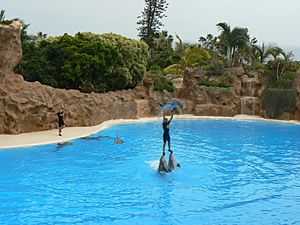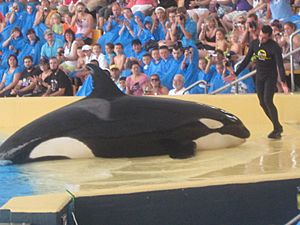Loro Parque facts for kids
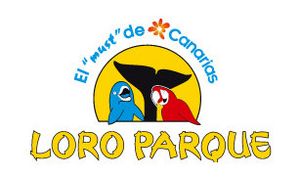
Loro Parque logotype
|
|
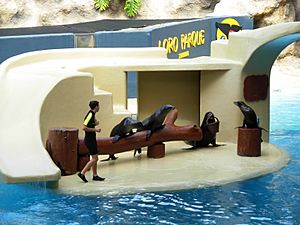
Sea lions perform in Loro Parque
|
|
| Date opened | 17 December 1972 |
|---|---|
| Location | Tenerife, Spain |
| Land area | 13.5 ha (33 acres) |
| Coordinates | 28°24′30″N 16°33′51″W / 28.40833°N 16.56417°W |
| No. of animals | 4,000 (parrots) |
| No. of species | about 350 (parrots) |
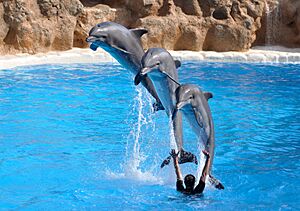
Loro Parque (which means "parrot park" in Spanish) is a huge zoo located near Puerto de la Cruz on the island of Tenerife, Spain. It covers an area of 135,000 square meters (about 33 acres). The park is home to many different kinds of animals and plants. It was first created to be a special place for parrots. Over the years, it has grown into one of the most popular attractions in the Canary Islands, welcoming over 40 million visitors!
Contents
A Look Back: Park History
Loro Parque first opened its doors on December 17, 1972. It was founded by Wolfgang Kiessling. Back then, it was much smaller, only 13,000 square meters (about 3.2 acres). It started with 150 parrots.
Since then, the park has grown a lot! Today, it is 135,000 square meters. It is now home to about 4,000 parrots from 350 different species and sub-species. This makes Loro Parque's parrot collection the largest in the world. It is a very important place for studying and helping to save these amazing birds.
Loro Parque also holds other records. It has the largest dolphin show pool in the European Union. It also has the world's biggest indoor penguin exhibition. Plus, it has the longest shark tunnel in the European Union. Loro Parque was also one of the first places in the European Union to have orcas.
The owners of Loro Parque also built another park called Siam Park. This is a large water park located in the south of Tenerife. It opened in 2008.
Amazing Birds at Loro Parque
Loro Parque is famous for its incredible collection of birds. You can see many different kinds, including parrots, black swans, golden pheasants, great curassows, and laughing kookaburras. The park also has penguins, puffins, flamingos, and pelicans.
Here are some of the many parrot species you can find at Loro Parque:
- Blue-headed parrot
- Burrowing parrot
- Eclectus parrot
- Rainbow lorikeet
- Alexandrine parakeet
- Crimson-bellied parakeet
- Green-cheeked parakeet
- Blue-winged parakeet
- Grey-headed parakeet
- Rose-ringed parakeet
- Blue-headed macaw
- Red-fronted macaw
- Golden-collared macaw
- Scarlet macaw
- Great green macaw
- Blue-and-yellow macaw
- Chestnut-fronted macaw
- Hyacinth macaw
- Red-bellied macaw
- Sulphur-crested cockatoo
- White cockatoo
- Salmon-crested cockatoo
- Blue-eyed cockatoo
- Gang-gang cockatoo
- Palm cockatoo
- Yellow-tailed black cockatoo
- Yellow-crowned amazon
- Red-spectacled amazon
- Red-lored amazon
- Blue-cheeked amazon
- Maroon-fronted parrot
- Kea
Other Incredible Animals
Besides the many birds, Loro Parque is home to a wide variety of other animals. You can see chimpanzees, western lowland gorillas, and emperor tamarins. There are also California sea lions, Asian small-clawed otters, and meerkats.
Other animals include red pandas, jaguars, white tigers, and lions. You might also spot pygmy hippos, capybaras, and giant anteaters. The park also has American alligators, Galápagos tortoises, and African spurred tortoises. Inside the aquariums, you can explore exotic fish, seahorses, and various sharks.
Meet the Orcas
Loro Parque is home to several orcas, also known as killer whales. In February 2006, four young orcas named Keto, Tekoa, Kohana, and Skyla arrived at the park. They came from SeaWorld.
On October 13, 2010, Kohana gave birth to a male calf named Adán. He weighed about 150 kg (330 lbs) and was two meters (6.6 feet) long. Adán has grown up with his family at the park.
In November 2011, a sixth orca named Morgan joined the group. Morgan was rescued in the Netherlands in 2010. Scientists later confirmed that Morgan has some hearing loss.
On August 3, 2012, Kohana had another calf, a female named Vicky. Vicky weighed 152 kg (335 lbs) and was 2.4 meters (7.9 feet) long. Sadly, Vicky passed away on June 16, 2013, due to intestinal problems.
In the summer of 2018, Loro Parque became the full owner of the orcas.
Sadly, Skyla passed away on March 11, 2021, due to gastric torsion. Kohana also passed away on September 14, 2022, due to a heart problem. Keto passed away on November 22, 2024.
As of August 2025, there are three orcas living at Loro Parque: Tekoa (a 24-year-old male), Morgan (a 16-17-year-old female), and Adán (a 14-year-old male).
Meet the Dolphins
Loro Parque also has 10 bottlenose dolphins. Three of them were rescued off Florida in the 1980s. The other seven were born at the park. Their names are Paco (male), Ruffles (female), Pacina (female), Ulisse (male), Luna (female), Clara (female), Cesar (male), Achille (male), Ilse (female), and Robin (male).
Exciting Shows and Attractions
Loro Parque offers many fun shows and attractions for visitors. You can watch amazing performances by sea lions (5 times a day) and dolphins (4 times a day). The "Loro Show" features parrots and runs 6 times a day. There's also "Nature Vision," an indoor cinema showing a 20-minute film (9 times a day). The orca show is also a highlight, performed 3 times a day.
Other attractions include "Kinderlandia," a children's playground, and the Gambian Market. You can also visit a parrot baby station and a large parrot museum. There are many restaurants where you can grab a bite to eat.
A scene from the 2005 movie The Hitchhiker's Guide to the Galaxy was filmed at Loro Parque.
Loro Parque Foundation: Helping Nature
In 1994, Loro Parque started the Loro Parque Fundación. This is an international foundation that works to protect nature and the environment. It is a member of the IUCN (International Union for Conservation of Nature).
The foundation has supported 82 conservation projects in 28 countries around the world. Currently, 31 of these projects are active, with about 150 people working every day to save nature. Since it began, the foundation has spent over $10,000,000 on these important projects.
The foundation is especially focused on saving the most endangered parrot species. They help through captive breeding programs, like with the critically endangered Spix's macaw. They also work on field projects, such as with the equally endangered indigo-winged parrot. Between 2017 and 2019, the foundation helped release fourteen captive-bred Great Green Macaws into a special reserve in Ecuador.
Awards and Recognition
Loro Parque has received many awards for its work. On September 27, 2000, the Canary Islands Government gave Loro Parque a very important tourism award called "Importante del Turismo 2000." This award recognized Loro Parque's great contribution to making the Canary Islands a top tourist destination. Wolfgang Kiessling also received another award for friendly tourism at the same time.
See also
 In Spanish: Loro Parque para niños
In Spanish: Loro Parque para niños


